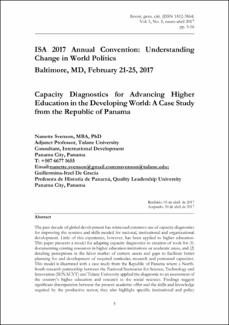| dc.contributor.author | Archer Svenson, Nanette | |
| dc.date.accessioned | 2023-12-20T00:58:14Z | |
| dc.date.available | 2023-12-20T00:58:14Z | |
| dc.date.issued | 2017 | |
| dc.identifier.citation | Svenson, N. (2017). Capacity Diagnostics for Advancing Higher Education in the Developing World: A Case Study from the Republic of Panama. Investigación Y Pensamiento Crítico, 5(1), 5–16. https://doi.org/10.37387/ipc.v5i1.61 | en_US |
| dc.identifier.issn | 1812-3864 | |
| dc.identifier.uri | https://repositorio.ciedupanama.org/handle/123456789/351 | |
| dc.description | The past decade of global development has witnessed extensive use of capacity diagnostics for improving the systems and skills needed for national, institutional and organizational development. Little of this experience, however, has been applied to higher education. This paper presents a model for adapting capacity diagnostics to creation of tools for (1) documenting existing resources in higher education institutions or academic areas, and (2) detailing perceptions in the labor market of current assets and gaps to facilitate better planning for and development of required curricular, research and personnel capacities. This model is illustrated with a case study from the Republic of Panama where a North-South research partnership between the National Secretariat for Science, Technology and Innovation (SENACYT) and Tulane University applied the diagnostic to an assessment of the country’s higher education and research in the social sciences. Findings suggest significant discrepancies between the present academic offer and the skills and knowledge required by the productive sector; they also highlight specific institutional and policy adjustments that would strengthen the university system overall and preparation in the social sciences at all levels. This paper refers to the Panama case in a broader discussion of how this research approach may be applied more broadly to inform policy for countries’ higher education systems, particularly in developing regions. As higher education becomes increasingly important for emerging economies’ competitiveness, potential for adoption of this model worldwide is considerable. | en |
| dc.description.abstract | The past decade of global development has witnessed extensive use of capacity diagnostics for improving the systems and skills needed for national, institutional and organizational development. Little of this experience, however, has been applied to higher education. This paper presents a model for adapting capacity diagnostics to creation of tools for (1) documenting existing resources in higher education institutions or academic areas, and (2) detailing perceptions in the labor market of current assets and gaps to facilitate better planning for and development of required curricular, research and personnel capacities. This model is illustrated with a case study from the Republic of Panama where a North-South research partnership between the National Secretariat for Science, Technology and Innovation (SENACYT) and Tulane University applied the diagnostic to an assessment of the country’s higher education and research in the social sciences. Findings suggest significant discrepancies between the present academic offer and the skills and knowledge required by the productive sector; they also highlight specific institutional and policy adjustments that would strengthen the university system overall and preparation in the social sciences at all levels. This paper refers to the Panama case in a broader discussion of how this research approach may be applied more broadly to inform policy for countries’ higher education systems, particularly in developing regions. As higher education becomes increasingly important for emerging economies’ competitiveness, potential for adoption of this model worldwide is considerable. | en |
| dc.format | application/pdf | en |
| dc.language.iso | en | en |
| dc.language.iso | en | en_US |
| dc.publisher | Investigación y Pensamiento Crítico | en_US |
| dc.rights | info:eu-repo/semantics/openAccess | en |
| dc.rights | https://creativecommons.org/licenses/by-nc-nd/4.0 | en |
| dc.subject | Higher education, assessment, capacity, labor market, developing country, North-South, Latin America, Panama | en_US |
| dc.subject | Higher education, assessment, capacity, labor market, developing country, North-South, Latin America, Panama | en |
| dc.title | Capacity Diagnostics For Advancing Higher Education In The Developing World: A Case Study From The Republic Of Panama | en |
| dc.type | info:eu-repo/semantics/article | en_US |
| dc.type | info:eu-repo/semantics/publishedVersion | en_US |
| dc.type | info:eu-repo/semantics/article | en |
| dc.type | info:eu-repo/semantics/publishedVersion | en |

